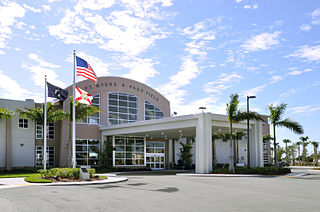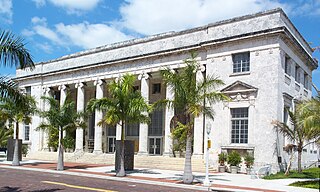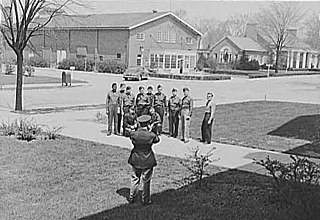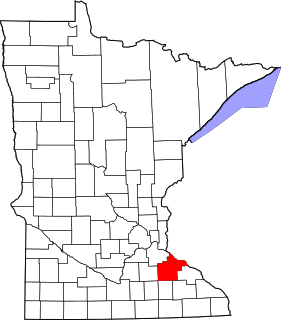
Lee County is located in Southwest Florida on the Gulf Coast. As of the 2010 census, the population was 618,754. The county seat is Fort Myers, and the largest city is Cape Coral with an estimated 2018 population of 189,343. Lee County comprises the Cape Coral–Fort Myers, FL Metropolitan Statistical Area.

Fort Myers or Ft. Myers, is the county seat and commercial center of Lee County, Florida, United States. As of the 2010 U.S. Census, the population was 62,298 and in 2019 was estimated at 87,103. Together with the larger and more residential Cape Coral, it anchors a metropolitan statistical area (MSA) which comprises Lee County and has a population of 770,577 in 2019.

Tifton is a city in Tift County, Georgia, United States. The population was 16,350 at the 2010 census. The city is the county seat of Tift County.

Fort Sheridan is a residential neighborhood within the cities of Lake Forest, Highwood, and Highland Park in Lake County, Illinois, United States. It was originally established as Fort Sheridan, an Army post named after Civil War cavalry general Philip Sheridan, to honor his services to Chicago.

Fort Benjamin Harrison was a U.S. Army post located in suburban Lawrence Township, Marion County, Indiana, northeast of Indianapolis, between 1906 and 1991. It is named for the 23rd United States President, Benjamin Harrison.

The Terry Park Ballfield is a historic site in Fort Myers, Florida, United States. The park is named after the family who donated the land in the 1920s. For years the stadium has hosted Major League Baseball spring training, as well as a dozen years of Florida State League baseball. The stadium has hosted the Philadelphia Athletics, Cleveland Indians, Pittsburgh Pirates, and Kansas City Royals spring training through the years. Terry Park was also home to some early minor league baseball, most notably the Fort Myers Palms and Fort Myers Royals, both belonging to the Florida State League. Hall of Famers Babe Ruth, Ty Cobb, Roberto Clemente, Jimmy Foxx, Bob Feller, Tris Speaker, and George Brett are some of the notable players that have played at Terry Park Field.

This is a list of the National Register of Historic Places listings in Dakota County, Minnesota. It is intended to be a complete list of the properties and districts on the National Register of Historic Places in Dakota County, Minnesota, United States. Dakota County is located in the southeastern part of the U.S. state of Minnesota, bounded on the northeast side by the Upper Mississippi River and on the northwest by the Minnesota River. The locations of National Register properties and districts for which the latitude and longitude coordinates are included below, may be seen in an online map.

This list is of the properties and historic districts which are designated on the National Register of Historic Places or that were formerly so designated, in Hennepin County, Minnesota; there are 176 entries as of October 2020. A significant number of these properties are a result of the establishment of Fort Snelling, the development of water power at Saint Anthony Falls, and the thriving city of Minneapolis that developed around the falls. Many historic sites outside the Minneapolis city limits are associated with pioneers who established missions, farms, and schools in areas that are now suburbs in that metropolitan area.

This is a list of the National Register of Historic Places listings in Goodhue County, Minnesota. It is intended to be a complete list of the properties and districts on the National Register of Historic Places in Goodhue County, Minnesota, United States. The locations of National Register properties and districts for which the latitude and longitude coordinates are included below, may be seen in an online map.

The Fort Madison Downtown Commercial Historic District has a collection of late-19th century store fronts centered on Ave. G, from 6th to 9th Street, and Ave. H from 7th to 9th, in Fort Madison, Iowa. It was listed on the National Register of Historic Places in 2007.

There are 69 properties listed on the National Register of Historic Places in Albany, New York, United States. Six are additionally designated as National Historic Landmarks (NHLs), the most of any city in the state after New York City. Another 14 are historic districts, for which 20 of the listings are also contributing properties. Two properties, both buildings, that had been listed in the past but have since been demolished have been delisted; one building that is also no longer extant remains listed.

The Lee County Courthouse is located in Fort Madison, Iowa, United States. The courthouse serves the court functions and county administration for the northern part of Lee County, and it is the county's first courthouse. It was listed on the National Register of Historic Places in 1976 as a part of the County Courthouses in Iowa Thematic Resource. In 2014, it was included as a contributing property in the Park-to-Park Residential Historic District. Southern Lee County is served from a courthouse in Keokuk in the former Federal Courthouse building.

Chief Justice Joseph M. Beck House is a historic building located in Fort Madison, Iowa, United States. It was individually listed on the National Register of Historic Places in 1984. In 2014 it was included as a contributing property in the Park-to-Park Residential Historic District.

The Albright House, also known as the William and James Albright Duplex and the Betsy Ross House, is a historic building located in Fort Madison, Iowa, United States. It was individually listed on the National Register of Historic Places in 1978. In 2014, it was included as a contributing property in the Park-to-Park Residential Historic District.

Chariton City Hall and Fire Station is located in Chariton, Iowa, United States. The combination building was designed by city engineer William L. Perkins, who had become known for designing residential and public buildings. The new facility came about because of the inadequate wood frame facilities they shared, and it was underscored by a fire that destroyed the center section of the south side of the town square in March 1930. While its dedication did not take place until March 1932, the city took possession of the completed facility in December 1931. An addition for the fire department was completed in 1979. While the asymmetrical facade and the recessed limestone surround of the main entrance reflects the Art Deco style that was popular at the time, the building's styling reflects the Neoclassical style. It is primarily found in the pilasters that flank the entrance, and the low relief emblems and festoons on the stone panels. The city hall\fire station was individually listed on the National Register of Historic Places in 2006. In 2014 it was included as a contributing property in the Lucas County Courthouse Square Historic District.

The Lansing Main Street Historic District is a nationally recognized historic district located in Lansing, Iowa, United States. It was listed on the National Register of Historic Places in 2014. At the time of its nomination the district consisted of 51 resources, including 42 contributing buildings, 8 non-contributing buildings, and one non-contributing site. The district covers most of the central business district, which is generally along Main Street. The commercial buildings are mostly masonry structures constructed with bricks or native limestone. A few buildings are frame construction with gable roofs. The buildings are from one to three stories in height, although most are no taller that two stories. The Italianate architectural style dominates. Most of the upper stories in the buildings housed retail or office space, but a few were residential. The commercial buildings that did not house retail establishments were located near the Mississippi River and were industrial in nature. The G. Kerndt & Brothers Office Block (1861) and the G. Kerndt and Brothers Elevator and Warehouses, No. 11, No.12 and No. 13 (1868) are individually listed on the National Register. Three public buildings are located in the district: the former jail and fire station, the Art Deco former City Hall (1938), and the modern U.S. Post Office.




















